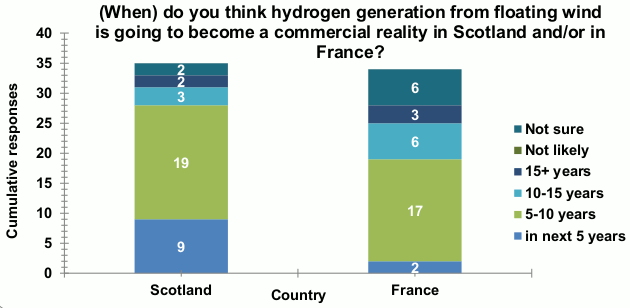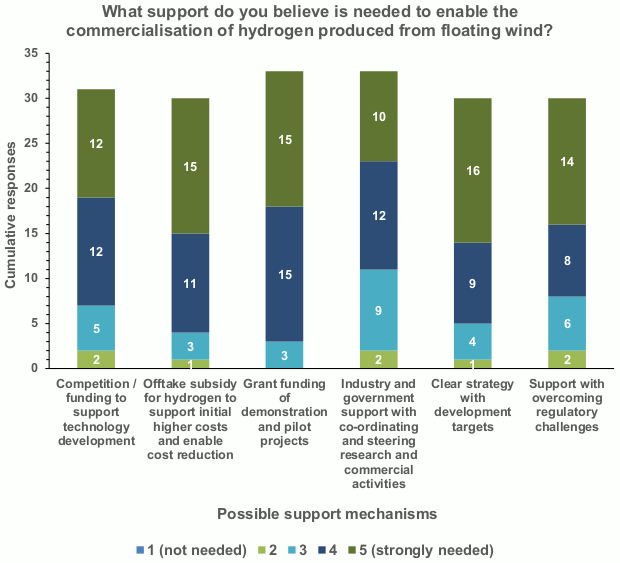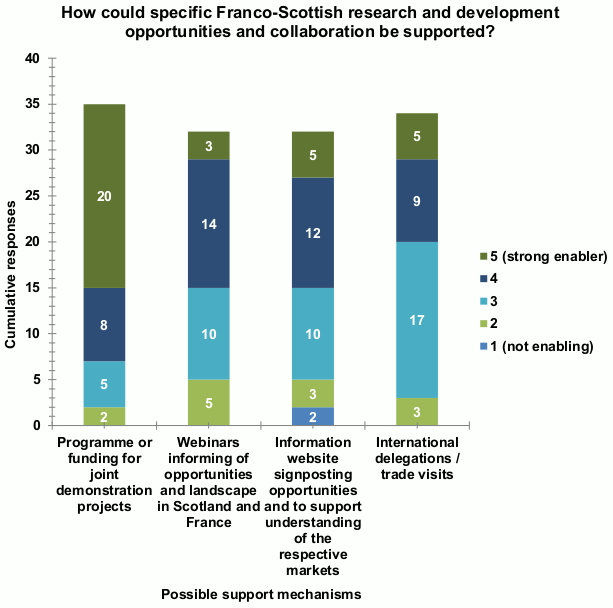Floating wind and green hydrogen - fostering future Scottish-French research and development collaboration: report
This report sets out the findings of a study undertaken for the Scottish Government which aimed to review the opportunities for Scottish and French organisations to work together to deliver collaborative innovation in floating wind and hydrogen.
Findings from engaging with supply chain stakeholders
As noted previously, supply chain stakeholders were engaged during the delivery of this research project. These stakeholders were invited to share views with the project team regarding the technical challenges they would prioritise for future research activities and their experiences of collaborative innovation projects. Participants were also asked to comment on their research and development support needs, and on proposed recommendations for possible Scottish Government intervention to develop Franco-Scottish collaborations. Stakeholders were engaged through questionnaires, expert interviews and discursive workshops.
36 questionnaire responses were received, from 12 organisations in Scotland and 24 in France. Five expert interviews were conducted, with three Scottish stakeholder organisations and two in France. Of the workshops, three were held. The first, which had a technical focus and was targeted at Scottish stakeholders only, drew 31 attendees representing 20 organisations. The second workshop, also with a technical focus and for French stakeholders only, had 21 attendees representing 15 organisations. The third workshop brought together a mixed group of Scottish and French stakeholders to discuss collaborative innovation initiatives, with 16 participants representing 11 organisations. Of those organisations, four were based in France and seven were based in Scotland.
Themes from Scottish stakeholder feedback from expert interviews and a technical workshop:
- Innovation should support technology deployments at scale: discussions with Scotland-based organisations placed very clear and explicit emphasis on a need for any initiatives targeting floating wind and hydrogen to support technology deployments at scale. Feedback suggested that driving deployments through innovation programmes could facilitate cost reductions more effectively than incremental innovation focused on improving individual system components. In these discussions, stakeholders suggested that industry representatives may be well placed to help shape the research focus required to address relevant technology challenges. Stakeholders reflected favourably on experiences of joint industry working.
“[We] need to be moving faster to deploy these technologies now. Typical renewable energy development timelines can run to ten years; it would be great if we could use research and innovation projects to short-circuit that to deliver cost reductions sooner”.
Quote from one Scottish supply chain stakeholder focused on the development of the hydrogen sector.
- Research could be used to de-risk future investment: underneath the notion of using future innovation initiatives to ‘support’ deployments at scale was an encouragement from stakeholders to prioritise research, development and demonstration activities which would de-risk future investment. This manifested in a request from stakeholders to ensure that future research programme design would anticipate investor perspectives and seek to develop activities which could contribute to easing the path for future commercial projects.
A key element of this feedback referred to perceptions shared by some stakeholders that it seems premature to consider in earnest an integration at scale of hydrogen and floating wind systems, when both are still in-development technologies in their own right. These stakeholders suggested that commercial projects at the interface of these technologies would likely be very risky currently. These stakeholders recommended that innovation activities focus specifically on continuing to mature the two technologies, alongside preliminary demonstrations of their co-deployment.
- Use collaborative innovation initiatives to build upon the existing skills base and supply chain competencies: supply chain strengths in Scotland in subsea engineering and in other services traditionally provided to the oil and gas sectors were highlighted by stakeholders. There was consensus among those consulted that future innovation developments in Scotland (and in outward international collaborations) should prioritise the identification of opportunities to leverage these skills and competencies in emerging sectors like floating wind and hydrogen. Stakeholders clearly recognised the value and importance of taking advantage of ‘Just Transition’ opportunities in delivering Scotland’s energy future.
One of the stakeholders also shared a positive experience regarding the impact of an employment support grant during the COVID-19 pandemic. Their organisation had been able to use the grant received to dedicate a staff member to carrying out an innovation, research and development audit, which provided scope to identify new opportunities for them in emerging energy technology developments. In this discussion, other stakeholders reflected on the challenge of developing innovation project pipelines while trying to manage their day-to-day business. Participants suggested that ‘Just Transition’ grant support mechanisms could be used similarly, to provide the financial headroom required for supply chain organisations to wrestle with the potential future opportunities emerging in floating wind and hydrogen. A further practical suggestion shared by stakeholders concerned a specific recommendation for a joint Franco-Scottish study looking at the technical feasibility of repurposing offshore energy infrastructure for hydrogen production and transport.
- Inter-regional collaboration may be ideally placed to address identified shared challenges and ambitions: Scottish stakeholders recognised the shared ambitions for floating wind and hydrogen development expressed by a number of leading regions in France. Reflections in these discussions also acknowledged that French regions are similar in scale (population, geography, economy) to Scotland, suggesting that inter-regional co-operation may be the most appropriate means of developing further Franco-Scottish joint working. In these discussions, stakeholders also noted the value of identifying challenges (and opportunities) shared by different regions between Scotland and France. Specifically, stakeholders expressed interest in establishing whether industrialised French regions may have similarly well-equipped oil and gas supply chains which could be transitioned towards working in floating wind and hydrogen development. Identifying supply chain competencies which are particular strengths in Scotland and in relevant French regions may provide fertile ground for exploring future collaborative programmes, for example, through knowledge exchange schemes.
Themes from French stakeholder feedback from expert interviews and a technical workshop:
- Fundamental technical questions and uncertainties were prominent in discussions with French stakeholders: the French participant group highlighted a keen need to understand where and how hydrogen would be produced in integrating the floating wind and hydrogen sectors. A key concern shared by French stakeholders was a lack of clarity in future market structures and market dynamics for floating wind and hydrogen in France (and internationally). This feedback further manifested in an expression of interest in seeing research activities specifically dedicated to developing commercial frameworks and business cases for these future sectors. These stakeholders would like to see research undertaken to better understand the energy system value of the offshore wind power that will be produced, before considering hydrogen business cases, but would also welcome research to clarify hydrogen supply and demand dynamics in Europe. Participants reflected on the role such work could play in de-risking commercial investments in future.
“The business cases for floating wind and hydrogen are not yet fully developed on their own [in France]. It would be helpful to better understand the commercial opportunity for each technology separately to inform future decision making”.
(Translated) reflection from a French supply chain stakeholder on research priorities for the floating wind and hydrogen sectors.
- On a technical front, these discussions highlighted interest among stakeholders in fundamental research looking at better understanding the implications of the range of scenarios envisaged for integrating floating wind and hydrogen. These participants encouraged the development of evidence bases establishing the advantages and challenges anticipated for deploying hydrogen production facilities onshore, with power connections to floating wind farms, or rather offshore, located adjacent to or within those wind farms. In the latter case, stakeholders would like to better understand the technicalities of whether electrolysis plants should be integrated within individual wind turbine platforms or centralised in a floating hydrogen plant. These discussions highlighted a number of uncertainties associated with integrating hydrogen and floating wind and set out clear priorities for initial further work which stakeholders would like to see undertaken.
In part stemming from shared perceptions that floating wind and hydrogen are relatively immature prospects in France, the role for early stage academic research was emphasised strongly in these discussions. In this regard, stakeholders acknowledged strong existing collaborations between French and Scottish institutions.
- Scottish ‘Just Transition’ ambitions are shared in France: in similar terms to discussions with Scottish stakeholders, French participants expressed a keenness to see research, development and innovation initiatives further explore opportunities for oil and gas supply chains to be supported in refocusing their efforts on supplying services for floating wind and hydrogen developments. Stakeholders specifically reflected on the potential value of inter-regional collaboration between Scotland and industrialised, littoral French regions in researching best practice in facilitating supply chain transition, and in exchanging knowledge on relative and complementary competencies of established organisations in both countries.
- There is nuance in the appropriate administrative level at which each challenge should be addressed: the French stakeholder group gave clear feedback to the project team regarding the need for initiatives to strictly be undertaken at the appropriate regional, national or European level, according to the division of administrative and legislative powers prevailing in France. In particular, participants focused on a need for many of the market and regulatory challenges highlighted by the project team to be addressed at a European level, given their cross-border implications.
However, these stakeholders also emphasised the opportunities for French regions with strong ambitions in floating wind and hydrogen to both learn from and share lessons with Scotland, and for organisations in the supply chains in these regions to work with Scottish counterparts. As noted above, participants shared a keenness to explore measures to support knowledge exchange and the sharing of best practice.
Themes in feedback from joint Franco-Scottish stakeholders on promoting collaborative innovation, from expert interviews and a technical workshop:
- International collaboration will be vital in further developing floating wind and hydrogen: across all stakeholder engagement activities undertaken for this research, stakeholders clearly expressed recognition of the value of, and need for, working together internationally. This is necessitated by the scale of the challenges and opportunities presented by developing both floating wind and hydrogen, and the roles foreseen for the two sectors respectively in delivering global energy transition. This ethos clearly underpinned all stakeholder feedback. This theme also manifested in stakeholder recognition that markets for both floating wind and hydrogen will develop across borders, and as such, innovation opportunities and energy supply-demand dynamics should be considered with international markets in mind. Across various sessions, stakeholders specifically encouraged efforts to avoid future innovation activities becoming ‘siloed’ as a result of not accounting for international aspects.
There was no ambiguity in stakeholder feedback regarding international collaboration: in every discussion undertaken in delivering this project, participants responded positively to, or explicitly recommended the virtues of, working together across borders to address outstanding research challenges. Stakeholders shared nuanced feedback in these discussions which recognised that valuable innovation activity need not necessarily or explicitly be undertaken in joint projects, given the reality that some solutions may be more appropriate for one market and not in another. Instead, these discussions focused on the need to better share findings from existing and future innovation activity, to better co-ordinate research activity and to disseminate the ‘lessons learned’. Practically speaking this feedback manifested in a recommendation or request from stakeholders for any proposed future Franco-Scottish initiatives to prioritise knowledge exchange in support of joint project delivery.
“[Scotland] cannot drive this alone. To deliver upon these ambitions for floating wind and hydrogen, there needs to be a collaborative push at a European level. Europe should be leading in this, and Scotland should be supporting that”.
A reflection from a Scottish supply chain stakeholder highlighting the importance of working together internationally.
- Cluster-building and networking initiatives support and facilitate future collaboration: stakeholders from both countries shared experiences with the project team regarding the importance of establishing connections to unlock opportunities for collaborative working. Cluster-building activities which bring together industry and supply chain organisations were recognised as enabling future activity in two ways. Firstly, discussion and knowledge exchange between representatives of organisations with different perspectives on a sector have been seen to encourage new ways of thinking, and have highlighted shared research interests. These exchanges have also enabled participants to move quickly together to address opportunities which emerge for collaborative working, for example, through funded innovation programmes. The latter aspect was noted by participants as being keenly important for developing collaborative consortia to pursue Horizon Europe projects and other similar funding streams.
Participants shared experiences on best practice in facilitating these connections and recognised that some exchanges occur organically through the meeting of stakeholders at industry events and conferences. However, comparatively formal and facilitated engagements through industry networks were also highlighted as useful measures. The Scottish Enterprise DeepWind cluster and in particular, its Power-to-X sub-group, were identified by participants as providing a particularly good case study of such an initiative through its facilitation of various collaborative industry and supply chain efforts.
“Maintaining awareness of what is happening elsewhere can be very difficult when you are busy. It can be easy to take a narrow view with a full inbox! International networks can help to provide prompts to flag new opportunities, and to make vital links”.
Feedback from an innovation consultant in Scotland, reflecting on the vital role that networks can play in driving collaborative activity.
Quantitative feedback from both Scottish and French stakeholders, from online questionnaire:
As noted above and in prior sections of this report, an online questionnaire was conducted and supply chain stakeholders from Scotland and France were invited to share their experiences in developing projects in the floating wind and hydrogen sectors. Respondees also shared their views on the state of the development of these sectors, and on the ways in which they could be supported to undertake collaborative innovation with their French or Scottish counterparts. The questionnaire drew 36 responses, including views from 12 Scottish organisations and 24 French organisations.
Respondee organisations were invited to participate through public-facing press releases promoting project research activities. Further potential participant organisations known to be actively undertaking projects in floating wind and hydrogen were contacted directly by the project team to invite them to participate. As such and given the relatively small sample size, results from this questionnaire should not be taken to be representative of these wider sectors and their supply chains. Instead these questionnaire findings provide a useful insight into stakeholder perceptions among a limited sample group, and could be used to scope and inform further research work in the future.

Stakeholders were asked to comment on when they foresaw commercial viability for hydrogen produced using power from floating wind farms, in Scotland and in France. Responses are summarised in Figure 4, with participants suggesting that they expect more rapid commercialisation in these sectors in Scotland. These findings also show lower overall confidence in the development of these sectors in France and reinforce stakeholder perceptions noted in the interview and workshop feedback narrated above.

In a subsequent question, stakeholders were asked to reflect upon the support needed broadly speaking to facilitate the commercialisation of hydrogen produced using power from floating wind. Responses are collated in Figure 5. Stakeholders notably expressed mainly favourable opinions to all of the proposed support measures. The highest scoring possible measure is that of grant funding for demonstration projects involving hydrogen and floating wind systems. This was followed by support from stakeholders for collaborative research and development co-ordination initiatives between public and private sector organisations, as well as the possibility of technology development competitions. These findings echo Scottish stakeholder workshop feedback, which reflected positively on experiences of joint industry project approaches to industrial research and late-stage technology innovation.

Finally, responding stakeholders were also asked to comment upon specific measures which could be used to encourage collaboration between the French and Scottish supply chains. Participant feedback is summarised in Figure 6. Stakeholders were especially supportive of the potential for joint Franco-Scottish demonstration programmes in floating wind and hydrogen. The second most popular proposal relates to international trade delegations or visits. Both of these findings align closely to previously narrated observations from both prior questions, and discursive workshop and interview feedback. In particular, the high positive score for possible trade delegations and visits in the future aligns well with stakeholder feedback which recommended a strong focus in future initiatives on cluster-building and networking as key supportive activities for fomenting future joint working.
Conclusions from engaging with supply chain stakeholders
In comparing and contrasting the range of stakeholder feedback provided to the project team, a number of clear shared innovation priorities and preferences emerge. The participants engaged through this study resoundingly support the development of joint research and development, and specifically demonstration projects, which should bring Scottish and French organisations together. Although stakeholders appeared to perceive the hydrogen and floating wind sectors to be more mature in Scotland than in France, there was also shared recognition from stakeholders that further work is required to understand how these two sectors can best be integrated.
Stakeholder groups in both countries also expressed great interest in understanding how existing skills and supply chain strengths from established oil and gas sector organisations could be applied to floating wind and hydrogen developments in practice. Given that the delivery of a ‘Just Transition’ is a core focus of the Scottish Government’s planning for these two target sectors, this would appear to be a very ripe area for future joint working initiatives. In discursive sessions with both Scottish and French stakeholder groups, participants specifically expressed an interest in seeing knowledge exchange and in the development of means of sharing best practice from prior transition programmes.
Stakeholders frequently reflected very positively on the value of and the need for networking and cluster-building activities. These initiatives were viewed as vital elements in forming project consortia ahead of funding calls.
These reflections from stakeholders informed the development of the recommendations set out in the following section.
Contact
Email: Alice.candy@gov.scot
There is a problem
Thanks for your feedback